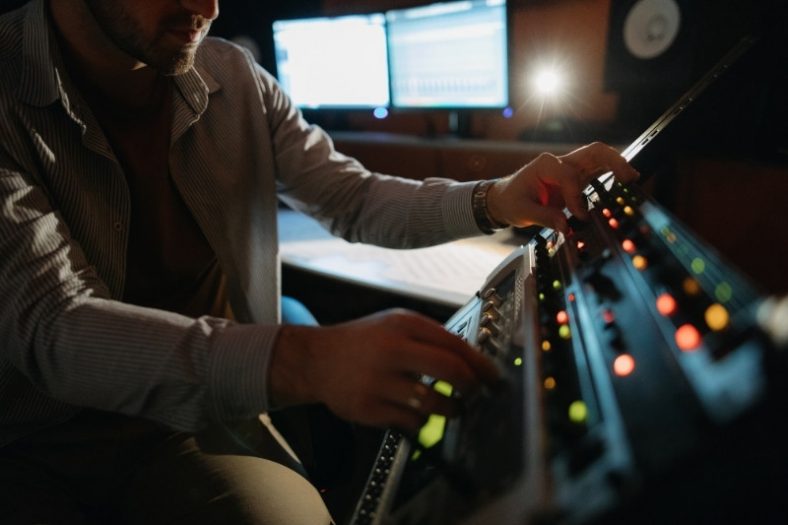10 Ways to Make Your Music More Interesting

Using audio effects in the master channel, adding syncopation to the arrangement, and sampling your own song are just some of the clever methods you can use to make your music more interesting. More often than not, small details are what separates a decent track from a top-tier song.
You’ve just finished a tune and you feel like it’s missing something? You’re probably not paying enough attention to the little things that turn a boring track into an exciting mix. Below, you can find 10 helpful tips to make your music more interesting.
Contents
- 1. Add sound effects
- 2. Sample your own song
- 3. Split chord patterns into multiple instruments
- 4. Add syncopation
- 5. Automate synth parameters and audio effects
- 6. Use silence
- 7. Add audio effects to the master track to create more variety
- 8. Boost your drums with a transient shaper
- 9. Add a percussion loop with a different time signature to the beat
- 10. Color your song with textures and atmospheres
- Summary
1. Add sound effects
This one may seem trivial at first, but it makes a huge difference. Adding sound effects to a finished track is an easy and clever way of making it pop. Things like tension-building risers before a drop and loud impacts at the start of a verse section can turn any amateurish composition into a professional-sounding banger.
Does this mean you need to buy expensive sound-effect packs? Not at all. You can easily use a reverse cymbal to create a makeshift riser or apply some reverb and distortion to a kick to make a loud impact. For more complex effects, try recording and processing your voice – simply “sing” the FX you need and use audio effects such as delay and compression to make it sound less like your voice.
2. Sample your own song
Effective for any track of any genre, this tip will help you to come up with new interesting sounds on the spot that won’t mess with the balance of your song. Adding samples to a finished track can be a nightmare but not if you’re using the finished track itself as the sample source.
Here are some of the things you can do by sampling your own song:
- Record all of the drums into a separate audio file, pitch the file 12 semitones up, double its speed, and get an instant percussion loop that should work wonders with your original drums.
- Cut a small portion of the vocals (just a syllable should do it) and play it in a sampler instrument to add an interesting hook to the song.
- Record the first beat of the most intense part of the song (such as the chorus) and load it into a sampler. Drop the sustain down to zero and get a playable hit sound that can be used to spice up boring sections.
3. Split chord patterns into multiple instruments
You have a beautiful piano chord progression, but now you want to turn it into a fuller, more interesting arrangement. You can do so by splitting the notes of the piano chords into separate instruments. This trick can work with anything, but it’s best when used with orchestral sounds (violin strings, wind sections, etc).
Imagine your first chord is a CMaj7. You can play the root (C) in a trombone, the 3rd (E) in a cello, the 5th (G) in a violin, and the 7th (B) in a clarinet. Without putting in too much work, you can easily turn a piano recording into a full-blown orchestral track.
4. Add syncopation
Some songs sound boring because they don’t have enough syncopation. If all the instruments are just hitting the main beats (the 1-2-3-4), it’s only natural that you find a track predictable and unexciting. To add syncopation to a song, all you have to do is play some notes or beats in the off-beat (the 1-and-2-and-3-and-4-and).
Adding the right syncopated groove to a finished song can be time-consuming, but a nice bass note or drum fill in the ‘and’ before the ‘1’ works wonders nine out of ten times (in the 1-and-2-and-3-and-4-and).
5. Automate synth parameters and audio effects
Textural movement is a big part of what makes a song interesting. When you have a track that’s way too repetitive and you don’t feel like coming up with a B section, you can always rely on the power of automation. Keep in mind that this tip only works if you’re using a DAW that allows you to automate audio effects and virtual synths.
Automation can be done manually if you have the time, but an LFO (like this one) is the best, easiest way to do it. You can use automation in a million different ways, but these are some of my favorites:
- Automating a small section of the cutoff filter in a virtual synth to add a feeling of swinging motion to a loop. The trick here is to pay attention to the LFO’s depth to make sure you’re not cutting or adding too much to the cutoff.
- Turning a static drone (such as a long bass note) into a bouncing rhythmic pattern. To do so, map the bass volume to the LFO and change the rate of the LFO to 1/8 or 1/16 (make sure it matches the BPM of your song). For the cleanest possible effect, use a square wave instead of a sine wave.
- Using delay artifacts to generate interesting new sounds on the spot. Some delay plug-ins such as Waves H-Delay or Ableton Live’s stock Delay automatically produce weird sounds once you change parameters such as the feedback and the delay time. Using automation in these parameters allows you to incorporate these tiny delay artifacts into your song. It’s perfect for fans of psychedelic music and trance producers, but you may want to snub the LFO and stick to manual automation for this one (precision is a must).
6. Use silence
Silence is one of the most underused tools in the world of music. Yet, it’s one of the most powerful concepts available to composers, producers, beat-makers, and even audio engineers. When a song stops, suddenly giving way to silence, it immediately grabs the attention of any listener.
It’s impossible to list all the different ways silence can be used in music, but the obvious one is to place it right before an exciting moment of the song (like the first chorus). By delaying the arrival of the chorus, you’ll be putting the listener in suspense. The listener may feel uncomfortable for a fraction of a second, but the release of the chorus will be much more satisfying.
You can use silence in any way you want to, but you should never forget to consider it. In composition, silence is a resource as fundamental as notes, beats, and timbres.
7. Add audio effects to the master track to create more variety
This one works for any genre of music, but it’s best suited for styles of electronic dance music such as techno, house, and trance. When you’re making EDM, you’re generally working with repetitive loops that may sound boring after one or two minutes of playing. Luckily, adding audio effects to the master track allows you to create more variety without necessarily changing anything about the song.
In a way, that’s what DJs do when they use EQ to momentarily cut the bass of a track. As a producer, though, you have access to a lot more control and many more creative tools. Adding a delay (with a 50% or less dry/wet value) for a brief moment can produce an interesting wobbly effect. A heavy distortion can highlight an otherwise weak section of the beat (for example).
For this one to work, make sure you’re automating the bypass button of the audio effect on the master channel. It’s also extremely important that you activate and deactivate the bypass at the exact moment. If the audio effect isn’t synced, it will sound less like an interesting detail and more like an unintentional mistake.
8. Boost your drums with a transient shaper
Arrangement and production tips are key to making music more interesting, but this one’s less about composition and more about mixing. You should try it out if you feel like the drums in your song are either not hitting hard enough or muddying the mix.
Often ignored, transient shapers are essential tools for mixing all kinds of drums and percussive sounds. They’re mainly used to control two things: the volume of the transient (i.e., the moment a beat hits/clicks) and the length of the sustain (i.e., how long it takes for a single beat to disappear/mute).
If your drums aren’t piercing through the mix, use a transient shaper like the SPL Transient Designer Plus to make the transients louder. If your drums are too muddy and getting in the way of the balance of the mix, use a transient shaper such as Pancz to shorten the length of each beat.
9. Add a percussion loop with a different time signature to the beat
Some websites suggest changing the time signature of a song to make it more interesting. It’s a good tip, but only if you want to change the song you’re working with to its very core (not to mention it’s extremely time-consuming). Luckily, there’s a smarter way of using alternative time signatures in a typical 4/4 song.
If you feel like your 4/4 beat sounds too static, you may be surprised by how effective it is to add a 3/4 beat to the mix. Make sure your 3/4 beat is mostly made out of sounds that are not too heavy (ethnic percussion or shaker sounds work best) and try not to make an overly-complex pattern.
Once you come up with a simple 3/4 groove that doesn’t get in the way of the original drums, your track should feel a lot more lively and less predictable. Because the hits in the 3/4 loop will hit at different instances of the original 4/4 loop, both your loops will sound less like loops and more like real humans playing. It’s a quick way of humanizing software drums.
10. Color your song with textures and atmospheres
This one is perfect if you’re working with genres such as post-rock, math rock, new age, ambient, or progressive electronic music. It’s about using textures and atmospheres to add sonic layers to a pre-existing song. The trick is to make sure your textures and atmospheres are either noise-based (such as field recordings and pure noise colors) or tuned to the fundamental key of the song.
If the textures and atmospheres you’re working with are tuned to your song or have no fundamental tune, you should be able to use pretty much any timbre, and as many timbres, as you’d like to. For a flawless mix, it’s important to make sure these background sounds aren’t too loud. Cutting the center and using just the side panning tracks can also be useful.
Summary
The devil is in the details. Sure, great hooks and choruses, banging sounds, and catchy melodies are the things that make a song fundamentally good or bad. However, good isn’t always interesting. To get the attention of an experienced music listener, you should add as much variety, color, and dynamism to a song as required.
Because almost everything is a double-edged sword in music, please keep in mind you shouldn’t add too much interesting stuff to a song either. If your song is already good and it just needs that extra little something, don’t overdo things as you may end up ruining your nice original idea.
Adding interesting details to a tune is a bit like cooking a meal. You need the perfect raw ingredients (the original song) and just the required spices (the little add-ons). If you add too much salt, you may end up ruining everything. But if the raw ingredients and the spices are harmoniously combined, you have made yourself a delicious dinner!





